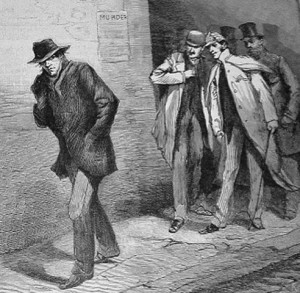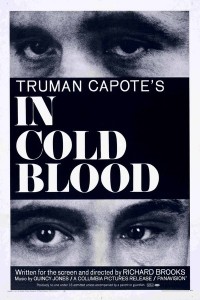by Nolan Doyle
Note: On the eve of the second episode of a series that documents one of the most culturally captivating “true crime” narratives of our time, American Crime Story: The People v O.J. Simpson, here are some thoughts on the significance of the genre.
The consensus was that no title on Jack the Ripper ever gathers much dust … the hottest backlist titles now, in the true crime genre, deal with serial killers
– the more gruesome and grotesque the better.[1]

The above quote comes from an article in Publisher’s Weekly in 1993. With some slight modification, it could have been published last week. True crime still dominates media from a publisher’s backlist to Netflix. As the quote suggests, this is not a new phenomenon. It is, has been for centuries, a genre of consistent popularity and dubious respect. Respect aside, literary or otherwise, I’ve noticed a recent trend: its titles are growing increasingly popular. It’s beginning to shake its Rodney-Dangerfield-syndrome.
What is True Crime?
In case the moniker doesn’t describe the genre sufficiently, a definition:
True crime is a non-fiction literary and film genre in which the author examines an actual crime and details the actions of real people.[2]
Do forgive the phrasing of this definition: it sounds just like the opening credits disclaimer for Law and Order: Special Victims Unit. As a work of fiction, SVU happens to be classified as a “legal drama,” a fact for your consideration. Unlike SVU, in true crime the author examines a real-life criminal case. The author acts as an investigative journalist, who reports to the audience. For the author, that it is an “actual” crime adds consequence and importance to the case. As for the viewer, that these are “real” people adds the gravity of human consequence. In tandem, it may be that the pleasure in a true crime narrative is in participation in a larger, culturally significant story. And, in the modern incarnation of the narrative, the degree of “audience participation” has been amplified.
Origins:
There has been much speculation with regard to the origin of “true crime.” One of those speculators and part-time true crime author, Joyce Carol Oates attempted to describe the phenomenon in 1999:
Accounts of true crime have always been enormously popular among readers. The subgenre would seem to appeal to the highly educated as well as the barely educated, to women and men equally.[3]
According to Oates, true crime does not have any intellectual barriers; anyone can participate. It seems to be the case that true crime is accessible. Since its accessible and engaging, it tends to be popular. As a function of its popularity:
“true crime” has become a crowded, flourishing field, though few writers of distinction have been drawn to it.[4]
That she says that few writers of distinction have been drawn to it is an interesting statement: with herself and Truman Capote as two that I can name off-the-cuff. Historic appeal to writers of distinction aside, a few things have changed since Oates wrote on the subject: namely, the subject matter and the storyteller’s medium.
Modern True Crime (continued in part two):
Once home to gruesome, grotesque retellings of serial killers’ lives and murderous careers, the genre has pivoted in an interesting, engaging way. Typically an arena for heavyweight investigative journalism (think: In Cold Blood) the genre has become host to the revisionist court case. The revisionist court case, where the author/investigator reports on the investigation and the audience supplants the jury.
Yesterday, the Broncos defeated the Panthers in the Super Bowl. A few times during the game, the referees went to the booth to review a call. This brought to mind something we consider in regard to revisionist procedure: in football, we live in an era of instant replay—where the audience knows better than the referee, or at least thinks that he does…
Note: In part two, let’s consider three important narratives in modern true crime: Serial, The Jinx, and Making a Murderer. With respect to these stories, a look at audience size and critical reception. With audience participation in mind, we’ll examine the legal, cultural consequences of each story and why we like to feel involved.
[1] David Schmid (2010). “True Crime”. In Charles J. Rzepka; Lee Horsley. A Companion to Crime Fiction. John Wiley & Sons.
[2] Ray Surette (2010). Media, Crime and Criminal Justice: Images, Realities, and Policies. Cengage Learning. p. 92.
[3] Oates, Joyce Carol (1999), “The Mystery of JonBenét Ramsey”, The New York Review of Books, Vol. 46, No. 11, 24 June 1999.
[4] Oates, Joyce Carol (1999), “The Mystery of JonBenét Ramsey”, The New York Review of Books, Vol. 46, No. 11, 24 June 1999.
